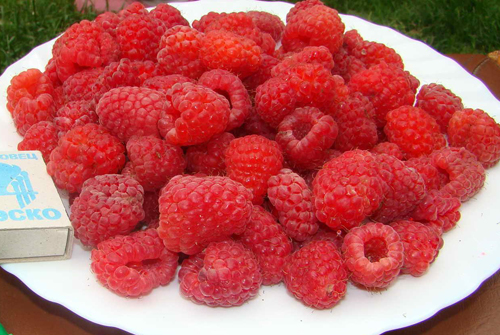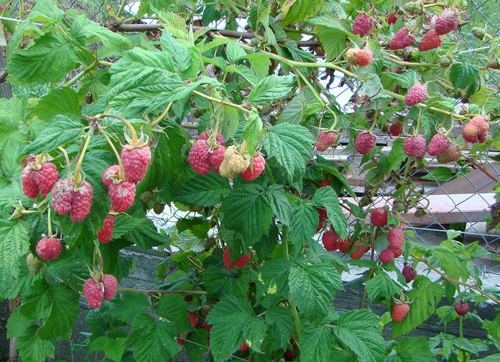Raspberry variety Maroseyka
The thorns have always annoyed summer residents and gardeners. The thorns mercilessly clawed at their hands, clung to clothes, defending raspberries from uninvited lovers of delicious berries. With a strong thickening of the bushes, picking fruits turned, without exaggeration, into a "battle for the harvest." And when not so long ago, studless varieties appeared on our market, this immediately aroused genuine interest in them among gardeners. And the first domestic variety with completely "bald" shoots was just Maroseyka. Moreover, she was born more than 30 years ago. But what else distinguishes our heroine in the berry world, in addition to the absence of thorns, is in our article below.

History of creation
The large-fruited summer raspberry variety Maroseyka was bred at the Moscow Institute of Horticulture and Nursery (VSTISP). Within the framework of the program for the exchange of planting material in 1977, the Russian professor V.V.Kichin received raspberry seeds. They were obtained by world renowned breeder Dr. Derek Jennings in 1976 from cross-pollination of 7324/50 × 7331/3 hybrids. Crossbreeding took place in Scotland. In the experimental plots of VSTISP in Moscow, seeds were sown in the same 1977th year. And in 1979, seedlings were selected under the number M228, corresponding to the desired characteristics. Then, having made sure of the stability of the obtained varietal qualities in new generations, the plants began to multiply and prepare for open sale. Since 1982, the "novelty" has been officially launched as a new variety under the name Maroseyka.
Interestingly, Dr. Derek Jennings himself has long suspended his research on breeding very large-fruited varieties. The reasons were their genetic instability, low frost resistance and often mediocre berry taste. And in our case, the period of 5 years, from the moment of sowing the seeds to the release of a new variety, is very, very little ...
Description
Maroseyka of medium early ripening period, begins to bear fruit from 8-10 July. In the southern regions it sings from mid-June. The bulk of the crop is harvested in 4-5 samples, the fruiting period lasts up to 1 month. Raspberries begin to bear fruit in the second year after planting, and enters full force when they reach the age of three.

The variety has good vigor, but the root growth gives an average amount and does not spread widely over the plot. The shoots themselves are medium-sized, slightly runny, powerfully developed, mostly 1.5, less often up to 1.7 meters high, spreading. During the season, 8-10 stems grow in the bush. Therefore, regular cutting of excess shoots and thinning of the bush itself are required to prevent strong thickening. And also it is necessary to carry out sanitary cleaning of plantings.
Annual shoots of Maroseyka are juicy green in color, resilient, strong, rather thick, with internodes of medium length, 3-5 cm each. They are pubescent - covered with a felt coating, absolutely thornless, the wax coating is insignificant. By winter they acquire a brownish-gray hue. Laterals (fruit twigs) of raspberry are medium-long, thickened, strong, elastic. They have 2-4 orders of branching, 10-20 or even more fruits are formed on them. The laterals are green; by the time the berries ripen, they can acquire an anthocyanin hue.
Mandatory installation of a support or trellis - without this, under the weight of large and numerous berries, the bushes will simply "fall apart" to the sides. Breaking off the head of the bush is also possible. Tying the stems in 2-3 places to the trellis wire will successfully solve this issue.
The leaves of the variety are medium and large, oval-diamond-shaped, with pronounced jagged edges. They are dark green in color, flat and slightly curled, strongly corrugated. Young leaves can be light green with a lemon tint, as if chlorosis. This shouldn't scare the grower. Raspberry blooms in May-June, the flowers are large, 1.5-2 cm in diameter, white in color. Collected in numerous dense brushes.

The berries of Maroseyka are really beautiful, elongated, blunt-conical in shape, with a wide base and significant tapering downwards, with a rounded nose, slightly pubescent. They are light red in color, sometimes pinkish-red, with a slight coating on the skin.
Fruits are large and very large, dense, elastic, weighing 4-12 grams, but can hold up to 16-18 grams. Their length is usually 2.5-3.5 cm, but they often grow up to 4-5 cm. The width is generally from 1.5 to 3 cm. The variety produces a very large percentage of double fruits. They do not have general uniformity and evenness, often the berries are slightly curved, deformed. But the double fruits of raspberries win in size - they come across in "dimensions" from a matchbox (both in length and in width) and even larger. Although the general quality and marketability of Maroseyka berries in this case is significantly reduced.
Drupes are medium in size, homogeneous, tightly adhered to each other. The seeds in them are medium-sized and few in number, practically invisible when the fruit is consumed. The berries are easily removed from the bush during picking, the separation is dry, not damaged and does not wrinkle in the hands. Overripe fruits hang on the bush for a long time without crumbling. But the quality of overripe berries drops dramatically, after picking they quickly wrinkle and flow. In this case, raspberries are suitable only for processing (and preferably at the place of collection) or for making raspberry wine and liqueurs.
The berries themselves are sweet, tasty, with a slight piquant sourness. Very juicy, the pulp just "melts in the mouth". The taste is close to real raspberry. The aroma is pleasant, soft, also really raspberry. According to these indicators, Maroseyka is much superior to another very large-fruited variety. Pride of Russia.

To be honest, I was personally always surprised by the enthusiastic exclamations of gardeners about "wonderful" twinned berries, comments like "an interesting feature of the variety", satisfied photos of sellers holding a matchbox next to "twin fruits" and the like, exposing it as an indisputable advantage of raspberries.
Firstly, this is not a feature, but a disadvantage. Such berries are called substandard all over the world. And there is only one way for them, for processing. Rather, there are two ways - I forgot about personal consumption, often straight from the bush. The quality of double berries is worse, the halves can ripen at the same time, rot, often the junction of the two halves is quite tough, it also ripens poorly, pubescence grows intensively there. I wonder if people would also be delighted if their dog suddenly had two-headed puppies?
Transportability and keeping quality of raspberries is at an average level, by three out of five points, especially for large fruits. In this, Maroseyka is an order of magnitude higher than the same Pride of Russia, which has these indicators at a very low level. To increase the keeping quality and transportability, especially of large berries, it is advisable to pluck them together with the stalk. Plus, together with the stalk, they look even more delightful. Have already described in other articles 100% "wow-effect".
The variety is more suitable for amateur gardening. Or small commercial plantings with a focus on the fresh berry market. Moreover, it is desirable that the place of sale is not too far from the place of collection. The fruits are also successfully used for fresh consumption, they can be dried, frozen. Maroseyka berries are very well suited for all types of processing (compotes, preserves, jams, marshmallows).
Despite the medium height shoots, the variety has a very good yield. They are perfectly loaded, the productivity of the bush is on average 4-5 kg. With competent agricultural technology (in particular, regular provision of moisture, the introduction of organic matter into the soil and timely feeding with macro- and microelements), this raspberry can almost double the yield.This variety is unlikely to be suitable for large-scale industrial cultivation, so it is advisable to talk about productivity from a hundred square meters. It is 180-200 kg, depending on the planting scheme and the number of shoots left per running meter of the row. In the case of Maroseyka, it is necessary to leave 5-6 stems in the bush with a distance of 50 cm between them, or, respectively, 10-12 pieces per linear meter. If there is enough free space on the site, it will not be superfluous to plant with a distance of 1 meter between plants in a row. In years with favorable weather and warm autumn, the variety can show partial remontability on already fruiting stems. Raspberries require regular moisture supply during fruiting, with insufficient watering, the berries become dry.
Winter hardiness at a medium-low level, as for the climate of most of Russia. Without shelter, the variety tolerates a drop in temperature to -25 ° C. In the south, it winters normally, but, for example, it freezes out regularly in the Middle Strip. Therefore, it will not be at all superfluous, in addition to bending down for the winter, also cover the shoots from above with protective material. For example, with dense agrofibre (lutrasil). This is especially true for regions where there are severe frosts and little snow, windy winters.
Maroseyka is resistant to the main diseases and pests of raspberries at the level of the best standard varieties. And even with a slight damage to the disease, it does not reduce the yield indicators.
Strengths
- Thornless, strong, upright shoots, protected by a wax coating.
- Very high yield rates.
- Beautiful, large and often really huge berries with a 100% wow effect.
- The variety is quite resistant to various negative factors.
- Sweet, juicy, tasty fruits with a slight sourness.
- Good raspberry berry aroma.
- Suitability of fruits for all types of processing, drying and freezing. However, after defrosting, they do not always retain their original shape.
- Resistant to major diseases and pests of raspberries.
- The berries hang on the bush for a long time without crumbling, tearing off during collection is dry, without effort.
Weak sides
- Quite sprawling shoots, the obligatory installation of trellises or supports is required. Plus, the bush grows widely, this must be taken into account when choosing a planting scheme.
- Maroseyka produces quite a lot of shoots during the season; moreover, the laterals have up to 4 orders of branching. Therefore, regular cutting of excess stems and twigs thickening the bush is required.
- There is no uniformity of fruits, a large percentage of doubled, slightly deformed and twisted berries.
- Average (up to -25 ° C) frost resistance.
- Transportability and keeping quality are average, especially for large fruits. Separation together with the stalk is advisable. Long distance transportation is problematic.
- When overripe, the berries are only suitable for processing and making wine.
The final conclusion, of course, is up to you. Better yet, make all the conclusions by planting a variety and observing it for 2-3 years. But I want to make a reservation right away - I am sure that Maroseyka will definitely not disappoint. This is indeed a very decent raspberry, but mainly for amateur cultivation in the country or garden.
Author: Maxim Zarechny.








